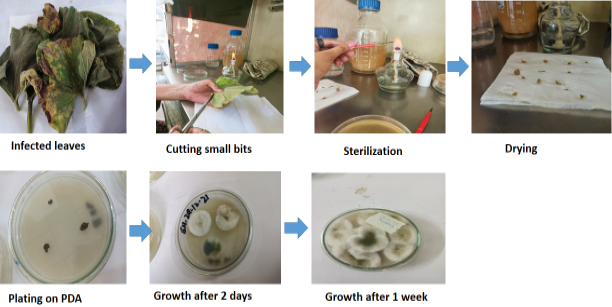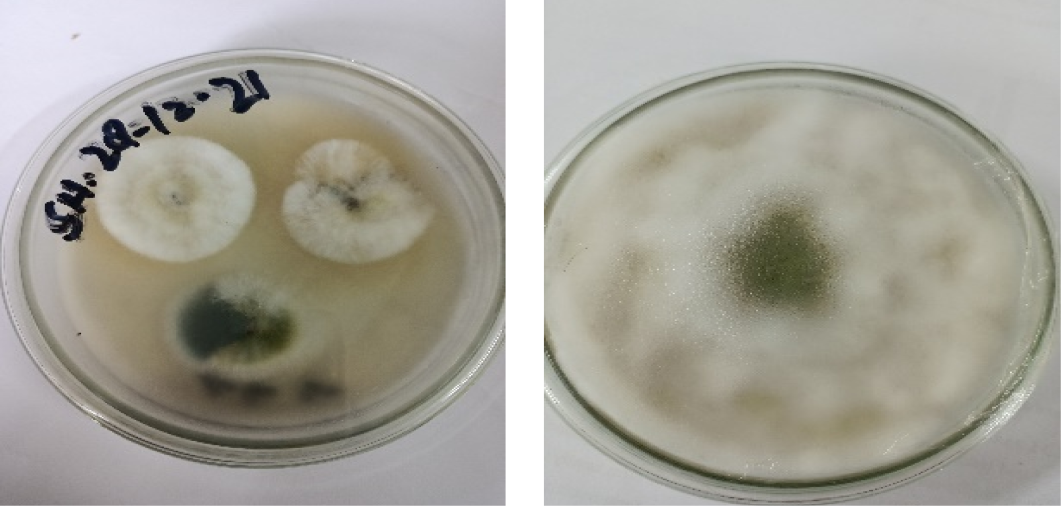Analysis of Fungal rDNA for the Identification of the Pathogen Associated Black Rot of Pumpkin
Sidra Hafeez1, Tayyaba Sanaullah2, Hafsa Naeem3, Mah Noor Hassan4, Muttalib5, Farhana Kausar6, Muhammad Salman Hameed7*, Muhammad Anayat Ullah8, Abdul Samad9, Memoona Bashir10 and Sadaf Shabbir11
1Plant Pathology, Agriculture University of Faisalabad, Pakistan; 2Department of Botany, Emerson University Multan, Pakistan; 3Department of Plant Pathology, Faculty of Crop Protection Sciences, The University of Agriculture, Peshawar, Khyber Pakhtunkhwa, Pakistan; 4The University of Central Punjab, Biochemistry, Lahore, Punjab, Pakistan; 5Department of Agriculture and Agribusiness Management, University of Karachi, Karachi, Pakistan; 6Department of Botany, University of Okara, Pakistan; 7National Key Laboratory of Green Pesticide, International Joint Research Center for Intelligent Biosensor Technology and Health, Central China Normal University, Wuhan 430079, P.R. China; 8Department of Plant Pathology, The University of Agriculture, Faisalabad, Pakistan; 9Institute of Home and Food Science GCUF, Government College University Faisalabad, Pakistan; 10Plant Pathology, University of Agriculture Faisalabad, Pakistan; 11Department of Food Science and Technology, Government College Women University Faisalabad, Pakistan.
*Correspondence | Muhammad Salman Hameed, National Key Laboratory of Green Pesticide, International Joint Research Center for Intelligent Biosensor Technology and Health, Central China Normal University, Wuhan 430079, P.R. China; Email:
[email protected]
Figure 2:
The Cultural Colonies of associated fungus D. bryoniae white aerial and olivacious mycelium observed that turned to green color in the center with white fluffy hyphal margins.
Figure 3:
(A) Pathogens (Didymella bryoniae) were validated by conducting the pathogenicity test through (Didymella bryoniae) Koch’s postulates. The pumpkin plants were grown in the pots in the greenhouse. The spore suspension (10°6conidia/ml) was prepared from 7 days old culture of the associated fungus (Didymella bryoniae) and was sprayed on the injured (pin prick method) leaves of 1-2 weeks old spinach plants grown in the pots. Symptoms appeared on the leaves after 7-14 days of inoculation. (B) Plants apparently showed the symptoms of light brown to dark brown spots with concentric rings and leaf margin are curled. These symptoms were compared with the original and pathogen was re-isolated to check the identity and pathogenicity.
Figure 4:
Total genomic DNA of associated pathogen (D. bryoniae) from two isolated SP1 and SP3.
Figure 5:
The results of PCR of internal transcribed spacer (ITS) region of rDNA and mitochondrial small-subunit of rDNA.
Figure 6:
Neighbor joining phylogenetic dendrograms based on an alignment of D. bryoniae and selected additional species’ projected nucleotide sequences (ITS region). The numbers at the nodes represent the percentage bootstrap confidence values (1000 replicates). Horizontal lines are proportional to predicted mutation distances, whereas vertical lines are arbitrary. The tree is randomly rooted to the nucleotide sequence of the distantly related Alternaria alternate (JQ074093.1) fungus.












